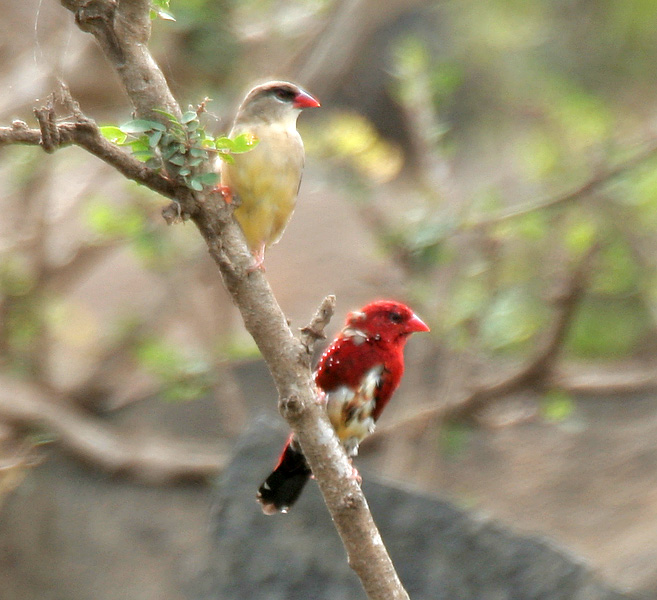 In addition to gorgeous coloration, the Strawberry Finch (Amandava amandava) possesses just about every other quality one could ask for in a finch. Both males and females sing sweetly year-round, and also amuse keepers with a variety of unique buzzing sounds and low “growls”. Their courtship and breeding behavior, which is displayed readily, is among the finch world’s most interesting. Small wonder they are perennial favorites in both the pet and zoo trade.
In addition to gorgeous coloration, the Strawberry Finch (Amandava amandava) possesses just about every other quality one could ask for in a finch. Both males and females sing sweetly year-round, and also amuse keepers with a variety of unique buzzing sounds and low “growls”. Their courtship and breeding behavior, which is displayed readily, is among the finch world’s most interesting. Small wonder they are perennial favorites in both the pet and zoo trade.
Range and Habitat
The three subspecies of Strawberry Finch occupy a huge range that extends from southern Nepal and Pakistan through much of Southeast Asia to Indonesia. It is a bird of marshes, swamps and other habitats near water, but also visits fields, gardens and farms while foraging.
The Strawberry Finch’s popularity has resulted in a number of intentional and accidental introductions. It is now established in such far-flung locales as Hawaii, Spain, Egypt, Fiji, Singapore and Puerto Rico (I imagine that a diligent search might turn up a few in Florida as well!).
Breeding Wild-Caught Individuals
I first made the Strawberry Finch’s acquaintance while working for a bird importer in the 1970’s. The original group we received contained a few males in breeding plumage – they were so breathtaking that I set them up in a large aviary in hopes that they would reproduce. We did well (or, rather, the birds did well!), with several pairs fledging 8 chicks each, but squabbles were all to frequent. Paired males make up for their diminutive size (4 inches) with fearless aggression, and keeping the peace was a constant chore.
 The youngsters that my birds produced, while vigorous, were somewhat somberly-colored. I soon learned that the adult coloration does not appear until age 2 years or so, which is quite an extended period for such a bird.
The youngsters that my birds produced, while vigorous, were somewhat somberly-colored. I soon learned that the adult coloration does not appear until age 2 years or so, which is quite an extended period for such a bird.
Also, unlike most other finches that appeared in the trade at the time, male Strawberry Finches exhibit 2 color phases each year – the brilliant scarlet feathers on the head, throat, rump and under-parts are evident only during the breeding season. Their non-breeding coloration, which resembles that of the female, is an attractive reddish-brown with white spots.
Colors Fade as Years Pass
However, when I began working with this species in zoos, I found that even as they matured and bred, captive-born individuals rarely attained the depth of red coloration I recalled in the wild birds I had handled years earlier. I spoke with others and learned that it was not my imagination – those who had seen wild Strawberry Finches agreed that they were far superior in color to captives. So what happened?
Further Reading
Please see this article for detailed info on Strawberry Finch varieties and captive care.
Video of a male giving his pleasant call.
Red Avadavat Male image referenced from wikipedia and originally posted by Vijay Cavale
Red Avadavat Pair image referenced from wikipedia and originally posted by J. M. Garg
 That Bird Blog – Bird Care and History for Pet Birds
That Bird Blog – Bird Care and History for Pet Birds



